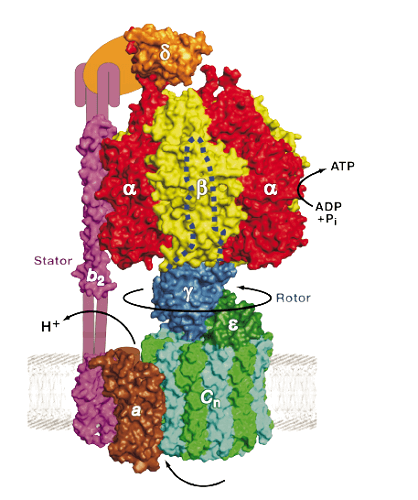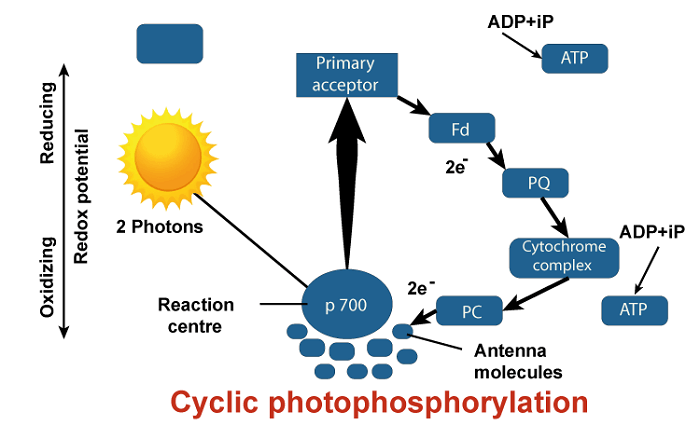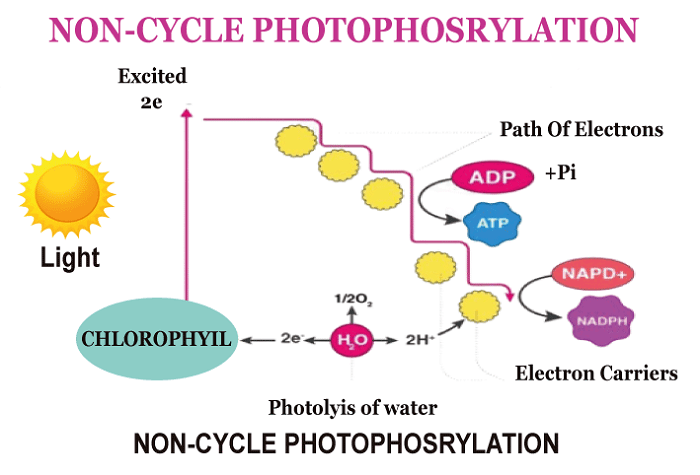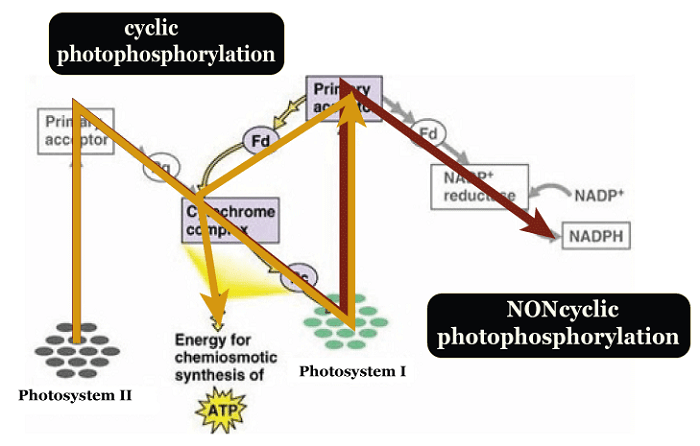Difference between Cyclic and Non-Cyclic PhotophosphorylationPlants compose their food by harnessing natural elements, such as water required for electron utilization and carbon dioxide for making food. They are also capable of absorbing the photons from sunlight. As later on, light energy is altered to chemical energy; it engages in a long and complex process of conversion of raw materials to glucose and oxygen. The emergence of ATP (adenosine containing three phosphate groups) molecules is necessary for the emergence of glucose. Due to the presence of sunlight, the ATP molecules are synthesized by including phosphate in ADP (Adenosine containing two phosphate groups) molecules. The two processes that take place during ADP synthesis are the Light and Dark reactions. In the light reaction, the light energy gained from the sunlight is transformed into chemical energy so that the formation of ATP and NADPH molecules in the chloroplast grana can occur. Photophosphorylation is also called light energy conversion, and respiratory chains are required. The electron donor with high energy and electron acceptor with low energy are formed in this process by using solar photons. On the other hand, in the Dark reaction, the ATP and NADPH are utilized to transform carbon dioxide into carbohydrates, which takes place in the stroma of the chloroplast. Also, the Calvin cycle is the dark reaction of photosynthesis. ATP is utilized to produce sugars during the Calvin Cycle. PhotophosphorylationOtto Kandler first discovered this process in 1950 after experimenting with intact Chlorella cells and concluded that the composition of ATP relies on sunlight. In 1954, a plant scientist named Danial I Arnon discovered the insulated chloroplasts in his lab using an isotope of phosphorus called P32. Through solar protons, the antenna complexes receive light energy, which is transferred to reaction centers; the electrons shift to the higher energy state and become excited. The electrons are forced towards the outer orbitals, and the protein attaches itself to the Electron transport chain. At last, the transformation from light energy to chemical energy takes place. The electrons from the chlorophyll are pulled by the proteins and then attached to the chain of proteins. The chemiosmosis reaction occurs during electrons' movement through different protein chains. The hydrogen ions are charged after the movement, and through the thylakoid membrane, the hydrogen ions move similarly as the electrons move. This movement of electrons and ions plays a significant role in forming ATP molecules from ADP in addition to phosphate and ATP synthase enzyme. The NADP+ molecule takes the electron after it has passed through the series of proteins in ETC, only to be reduced to NADPH, where NADP+ serves as an electron carrier. NADP+ + H+ → NADPH (Nicotinamide adenine dinucleotide phosphate) This reaction takes place during the non-cyclic reaction. If it had been cyclic photophosphorylation, the electron, instead of reacting with the NADP+ molecule, would have returned to the reaction center, and the flow of electrons would start again. As the electrons flow downward from the primary electron acceptor to P700 and this concludes with the formation of ATP. Solar energy splits the water molecules through the process of photodissociation. The oxygen molecules, protons, and electrons are yielded. The electrons are transported to chlorophyll as they must replace the lost electrons. From here, the non-cyclic photophosphorylation commences, and the photon ions are discharged in the cell and then as a waste product. Light energy → Antenna complex → Reaction center in Chlorophyl → Electric Transport chain → PMF (proton motive force) → ATP molecule ATP SynthaseATP is present in all the living forms discovered yet. These energy-storage molecules are produced due to the enzyme called ATP synthase. It functions through the TEP channel or proton channel. This ETC works to develop an ATP descent. The chemical constituents and light energy that compose the charge form ATP molecules, and all organisms function due to some specific oxidation-reduction reactions. This process is called the proton motive force. The oxidation-reduction reactions shift electrons from the donor molecule to the acceptor molecule. If the reaction is kinetically constrained, the speed of the reaction lessens, and Gibbs free energy is lowered as well. 
Electron Transplant Chains (ETC)The ETC elements are found in the plasma membrane of prokaryotes. On the other hand, in eukaryotes, many imitations of ETCs could be located in the cell membrane. It is one of the two parts of Oxidative phosphorylation (this process generates the energy-rich phosphate bonds through the reduction of oxygen for the setting up of ATP molecules), which is built through the accumulation of four protein chains attached to the inner membrane of mitochondria in which electrons go through cycles of redox reaction. The four protein chains attached to the membranes are:
The redox reactions function to form ATP molecules by producing electrochemical protons. This aerobic process ends with the acceptance of the final electron by molecular oxygen. Also, an electron travels from a higher to a lower energy level through a downhill transport system, as the electron transport system cannot utilize the electrons. So, they are further passed to photosystem 1, considered downhill in the redox probability scale. 1. Cyclic PhotophosphorylationAfter advancing through a range of electron carriers, the electron returns to the electric photosystem. This process is known as Cyclic Photophosphorylation. This process occurs when the wavelength of light is less than 680 nm, and the carbon dioxide fixation is repressed. The protein chains later use the energy released during the electron transfer to force them into the membranous cavities and away from the mitochondria. This movement pushes H+ ions to produce a concentration gradient which is further utilized to advance ATP synthase for the next major step, i.e., chemiosmosis. In this process, oxygen and NADPH+ molecules are not produced. This process can take place in both aerobic and anaerobic conditions. 
The Antenna complexes are present as layers of green leaves, which transfer the solar protons toward the reaction centers and then to the electron transport system. Chlorophyll a is a plant reaction center, whereas carotenoids and Chlorophyll b serve as antenna complexes. 2. Non-Cyclic PhotophosphorylationThis process works opposite to cyclic photophosphorylation. The electrons expelled by the excited photosystem do not return to it after the series of redox reactions. The constant water supply is the primary requirement as the electrons are discharged due to the photolysis of water. The energy utilized in synthesizing ATP molecules is contributed by the excited electrons supplied by photosystem II. The entire motion of the electrons is non-cyclic because the photosystem I primary electron donor acquires the place of the photosystem II primary electron donor, and the lost electrons do not revert to P680. The primary acceptor delivers the electrons released from P700 to the NADP. Combining electrons and protons in H+ molecules (through splitting water molecules) reduces NADP. 
This process includes two distinct chlorophyll photosystems in the thylakoid membrane. Through the process of photolysis, the splitting of water molecules takes place. The two electrons of water molecules are maintained in photosystem II. On the other hand, the protons and oxygen molecules are discharged for other uses. Later, the chlorophyll pigments absorb a photon as it encircles the reaction core center of the photosystem. The energy is transferred to the center of photosystem II because of the chain reaction that commences after light in electrons and the stimulation of two electrons transported to pheophytin or a primary electron acceptor. In PSII, Plastoquinone serves as an electron-proton moderator. The 2 electrons from the primary electron acceptor and two hydrogen ions are extracted by Plastoquinone from the stroma to form Plastoquinol (PQH2). However, it splits into PQ, and the 2 electrons are freed in the Cytochrome B6f complex, and the two hydrogen ions are lost in the thylakoid spaces. After traveling along the Cytochrome b6 and Cyt f, the electrons passed through the plastocyanin to supply the energy for the H+ ions to be embedded in thylakoid spaces. As the gradient is yielded, the ions of hydrogen flow back toward the stroma. This provides the chloroplast with the energy for ATP reformation. Unlike the cyclic pathway, the 2 electrons do not go back to photosystem II. Instead, the replicated electrons are transferred to photosystem I to reach a higher energy level due to the solar energy photon. The enzyme called Flavodoxin -NADP reductase uses the stimulated electrons to catalyze this redox reaction. NADP+ 2H+ + 2e- → NADPH + H+ The hydrogen ions are dissipated in this reaction, and the by-products gained are ATP, ½ O2, and NADPH+H+. With the help of light energy and water, these reactions occur during the second stage of photosynthesis. The non-cyclic flow of electrons changes into cyclic if the chloroplast is low on ATP level for the Calvin cycle to occur, and the NAPH will get piled up. Differences between Cyclic and Non-Cyclic Photophosphorylation
The cyclic and non-cyclic photophosphorylation are the stages that occur during the formation of ATP molecules in plants.
Next TopicDifference between
|
 For Videos Join Our Youtube Channel: Join Now
For Videos Join Our Youtube Channel: Join Now
Feedback
- Send your Feedback to [email protected]
Help Others, Please Share










